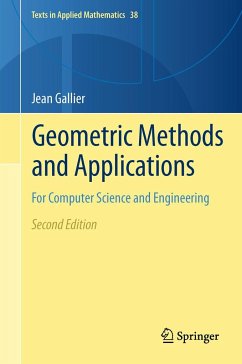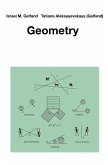This book is an introduction to the fundamental concepts and tools needed for solving problems of a geometric nature using a computer. It attempts to fill the gap between standard geometry books, which are primarily theoretical, and applied books on computer graphics, computer vision, robotics, or machine learning.
This book covers the following topics: affine geometry, projective geometry, Euclidean geometry, convex sets, SVD and principal component analysis, manifolds and Lie groups, quadratic optimization, basics of differential geometry, and a glimpse of computational geometry (Voronoi diagrams and Delaunay triangulations). Some practical applications of the concepts presented in this book include computer vision, more specifically contour grouping, motion interpolation, and robot kinematics.
In this extensively updated second edition, more material on convex sets, Farkas's lemma, quadratic optimization and the Schur complement have been added. The chapter on SVD has been greatly expanded and now includes a presentation of PCA.
The book is well illustrated and has chapter summaries and a large number of exercises throughout. It will be of interest to a wide audience including computer scientists, mathematicians, and engineers.
Reviews of first edition:
"Gallier's book will be a useful source for anyone interested in applications of geometrical methods to solve problems that arise in various branches of engineering. It may help to develop the sophisticated concepts from the more advanced parts of geometry into useful tools for applications." (Mathematical Reviews, 2001)
"...it will be useful as a reference book for postgraduates wishing to find the connection between their current problem and the underlying geometry." (The Australian Mathematical Society, 2001)
This book covers the following topics: affine geometry, projective geometry, Euclidean geometry, convex sets, SVD and principal component analysis, manifolds and Lie groups, quadratic optimization, basics of differential geometry, and a glimpse of computational geometry (Voronoi diagrams and Delaunay triangulations). Some practical applications of the concepts presented in this book include computer vision, more specifically contour grouping, motion interpolation, and robot kinematics.
In this extensively updated second edition, more material on convex sets, Farkas's lemma, quadratic optimization and the Schur complement have been added. The chapter on SVD has been greatly expanded and now includes a presentation of PCA.
The book is well illustrated and has chapter summaries and a large number of exercises throughout. It will be of interest to a wide audience including computer scientists, mathematicians, and engineers.
Reviews of first edition:
"Gallier's book will be a useful source for anyone interested in applications of geometrical methods to solve problems that arise in various branches of engineering. It may help to develop the sophisticated concepts from the more advanced parts of geometry into useful tools for applications." (Mathematical Reviews, 2001)
"...it will be useful as a reference book for postgraduates wishing to find the connection between their current problem and the underlying geometry." (The Australian Mathematical Society, 2001)
From the reviews:
"This is a worthwhile book to have in the library of any univeristy which is involved with these areas of computer science." (The Mathematical Gazette, 2002)
"The treatment of each topic is in depth and to the point. It is a rigorous theorem-proof approach on the one hand, but there are plenty of comments and remarks that make for easier reading." (SIAM Review, 2002)
From the reviews of the second edition:
"The book contains a valuable collection of modern geometric methods and algorithms readily prepared for solving problems occurring in computer science and engineering. ... The second edition is even more comprehensive and puts more emphasis on the links between different fields. It can be recommended to anybody who is interested in modern geometry and its applications." (Anton Gfrerrer, Zentralblatt MATH, Vol. 1247, 2012)
"Anyone who likes to read about geometry, differential geometry, linear algebra, or Lie theory should find something of interest in this book. ... this is, of course, a text in geometry, and many aspects of it are covered. ... this book is filled with interesting mathematics, superbly presented. Aside from its potential use as a text, the book should be looked at by anyone who uses or is interested in the topics covered. It is highly recommended." (Mark Hunacek, The Mathematical Association of America, September, 2011)
"This is a worthwhile book to have in the library of any univeristy which is involved with these areas of computer science." (The Mathematical Gazette, 2002)
"The treatment of each topic is in depth and to the point. It is a rigorous theorem-proof approach on the one hand, but there are plenty of comments and remarks that make for easier reading." (SIAM Review, 2002)
From the reviews of the second edition:
"The book contains a valuable collection of modern geometric methods and algorithms readily prepared for solving problems occurring in computer science and engineering. ... The second edition is even more comprehensive and puts more emphasis on the links between different fields. It can be recommended to anybody who is interested in modern geometry and its applications." (Anton Gfrerrer, Zentralblatt MATH, Vol. 1247, 2012)
"Anyone who likes to read about geometry, differential geometry, linear algebra, or Lie theory should find something of interest in this book. ... this is, of course, a text in geometry, and many aspects of it are covered. ... this book is filled with interesting mathematics, superbly presented. Aside from its potential use as a text, the book should be looked at by anyone who uses or is interested in the topics covered. It is highly recommended." (Mark Hunacek, The Mathematical Association of America, September, 2011)








